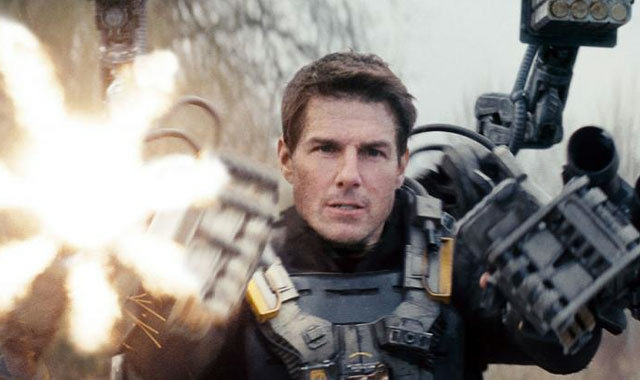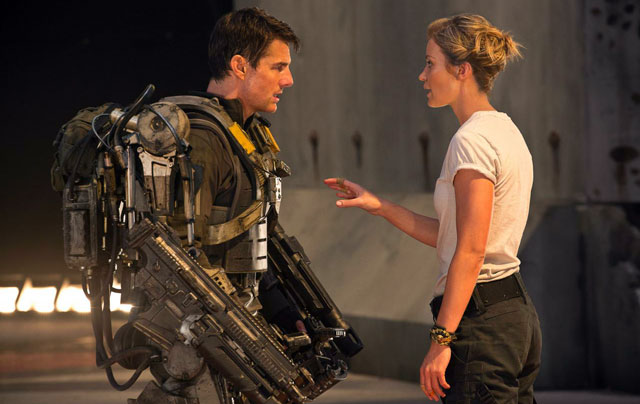
Though it’s not directly based on a videogame, the new Tom Cruise vehicle Edge of Tomorrow nails the aesthetics and feel of one more accurately than any film to come before it. It’s a variant on the Normandy landing level so favoured by designers of first-person shooters, but handled with enough suspense and intelligence to be better than that description might suggest.
Edge of Tomorrow’s “Live. Die. Repeat.” tagline brings to mind the punishing gauntlets of Call of Duty and similar games, where a player may die and respawn multiple times before success as he fights his way up a beach. Each death is an opportunity to start again with fresh memories of enemy placement and a new understanding of how the hostile artificial intelligence behaves.
Cruise stars as smarmy public relations guy Major William Cage, who works for a Nato-led defense force engaged in a desperate war with an alien race known as the Mimics who have conquered all of Europe. Cage is forced against his will to be at the frontline of an ill-fated D-Day style invasion to take back the continent. The cowardly and untrained Cage dies soon after the landing, but not before being drenched in the blood of an Alpha Mimic he kills in the battle.
He wakes up to find that the day has been reset to its beginning — and each time he dies from then on, he relives his D-Day (it’s no coincidence that its US opening was on 6 June, the 70th anniversary of D-Day). Tough war hero Sergeant Rita Vrataski (Emily Blunt) is the only one who understands what is happening to him and undertakes to train him every day until he is good enough to reach and defeat the alien boss directing the invasion — the Omega hive mind.
Edge of Tomorrow is loosely based on a Japanese young adult novel by Hiroshi Sakurazaka, more memorably titled All You Need is Kill. Doug Liman — who proved his chops at directing action with the first and best Jason Bourne movie — handles his time-looping narrative structure with dexterity and his set pieces with muscular confidence.
The Groundhog Day-like concept of a man living the same day over and over again holds potential to become repetitive, but Liman manages to make each day feel fresher for his audience than it does for the hapless Cage. Every time the day folds back on itself, Liman finds a way to surprise with a new insight into one of his characters or perhaps a glimpse of something new that happens when Cage survives for a few more minutes.
The action scenes are slick and propulsive, blending practical effects and computer-generated imagery into seamless spectacle. The design of the Mimics and the exoskeleton body armour the human soldiers wear into battle is particularly impressive, recalling at once the sleek designs in games like Halo and the iconic look of Paul Verhoeven films like Starship Troopers.

Liman, who must take some of the credit (or blame) for the love of shaky camerawork that took hold of Hollywood after The Bourne Identity, uses a fair amount of handheld camera footage to immerse the viewer in the chaos of the war. However, Edge of Tomorrow is robbed of some of its potential impact to by the decision to aim for a PG rating. For a film that replicates a science-fiction version of the Normandy invasions, it feels somewhat bloodless. One can only imagine the ghoulish delight with which Verhoeven would’ve dispatched Tom Cruise in increasingly inventive ways if he’d directed this film in the late 1980s.
Still, Liman manages to find a great deal of black humour in his videogame-like structure as Cage tries to learn and commit to muscle memory the exact patterns of behaviour that will let him win. Anyone who has played a videogame knows the frustration of having blown a level, and killing his avatar off with a mutter of disgust and irritation. The same happens here to Cage a number of times, often to comic effect.
Edge of Tomorrow’s biggest asset, however, is the charisma of its stars. Love or hate Tom Cruise, he’s good at any role that requires him to find the grit and courage below an easy smile and yellow-bellied demeanour. He’s better here than he was in last year’s Oblivion, a science-fiction film with visionary visual design, a terrific score and an awful script.
Blunt almost steals the film from Cruise as the terse, hard-nosed “Angel of Verdun”. Rita Vrataski is the strong one, the competent one. She’s a character of steely integrity, yet there is a vulnerability below her surface that humanises her. The only disappointment is that the script is compelled to introduce a note of romantic sentimentality into her relationship with Cage.
Edge of Tomorrow isn’t likely to be remembered as a classic in years to come because it’s not quite as subversive as, say, Starship Troopers, or as mind-twisting as, for example, Inception. There are also some glaring plot holes. But it’s an extraordinarily well-made summer blockbuster with a smart premise, good visual effects and a tone that strikes a healthy balance of between self-aware humour and seriousness. — © 2014 NewsCentral Media

